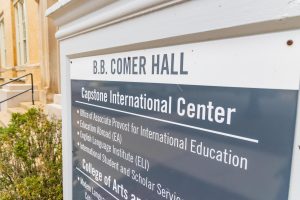Understanding the University’s financial footprint
August 17, 2022
Before the COVID-19 pandemic, the University of Alabama brought more than $2 billion in revenue to the Tuscaloosa metro area per the latest economic report.
A 2019-2020 economic impact report, conducted by the Center for Business and Economic Research in the Culverhouse College of Business revealed the financial benefit of the campus on Tuscaloosa’s community.
The University is the largest employer in Tuscaloosa per the city of Tuscaloosa’s fiscal year 2021 annual comprehensive financial report.
University employees and families made up roughly half of the city’s 100,000-person population, not including the more than 38,000 students that were enrolled at the time. The University employed over 7,100 people in the 2019-2020 academic year.
Samuel Addy, associate dean for economic development in the Culverhouse College of Business, told UA News on April 28 that “a lot of growth and development in the Tuscaloosa area is more or less driven by growth at the University.”
The Division of Strategic Communications stated in the same article that “economic impact derives from three main areas: direct spending by UA, student spending and visitors.”
According to the CBER impact report, “UA expenditures for the year totaled $1.577 billion.” The University spent “$516 million on payroll and $517.7 million on purchases.”
Student spending on off-campus housing, food and other necessities equaled $542.8 million in 2019-2020.
The economic impact report also stated that compared to in-state students, out-of-state students spend more while attending the University.
As a result, out-of-state students create “educational tourism” opportunities.
There was also an impact from visitor spending. In fall 2019, football games brought in about $26.6 million per game. The Tuscaloosa metro area saw an estimated $19.8 million in visitor expenditure.
A conservative estimate of $42.7 million in city and county sales tax came from the University, according to the News Center story. This estimate did not include property and business tax influenced by The University’s community.
Shane Dorrill, the assistant director of communications, said the University helps the Tuscaloosa economy through The EDGE program.
The EDGE is compromised of The University of Alabama, the West Alabama Chamber of Commerce and the city of Tuscaloosa.
The EDGE was started in 2012 and works to connect entrepreneurs with workspaces, innovators, and assistance, per the official The EDGE website.
Russell Mumper, vice president for research and economic development at the University, said that “in goal 2 of the UA strategic plan ‘Advancing the Flagship: The Next Phase (2022-2027),’ UA remains committed to promoting innovation and research in ways that positively impact economic and societal development.”
When asked about seasonal impacts, Ahmad Ijaz, executive director and director of economic forecasting at the Culverhouse Center of Business and Economic Research, said that “activities still take place at The University,” even when students are gone, so usually only an annual impact is done.
The Crimson White contacted Kevin Lake, marketing and communications manager for Tuscaloosa, regarding an estimate on revenue brought in from student spending, but Lake directed to answers complied within the economic report.



















![UPDATE | New details have emerged about U.S. Immigration and Customs Enforcement’s arrest of doctoral student Alireza Doroudi.
— Yesterday, a University spokesperson confirmed that a doctoral student was arrested by federal immigration authorities, without providing the student’s name, declining to share specific information due to federal privacy laws.
“International students studying at the University are valued members of the campus community, and International Student and Scholar Services is available to assist international students who have questions,” said Alex House, associate director of media relations for the University. “UA has and will continue to follow all immigration laws and cooperate with federal authorities.”
— An employee at the Pickens County Jail confirmed that Doroudi is being held there, adding that the facility typically sends ICE detainees to a detention facility in Louisiana.
— The Department of Homeland Security provided a statement about Doroudi’s arrest:
“ICE HSI [Homeland Security Investigations] made this arrest in accordance with the State Department’s revocation of Doroudi’s student visa. This individual posed significant national security concerns,” a DHS spokesperson said. The statement did not provide details about why it claimed Doroudi posed national security concerns.
— Students for Justice in Palestine at UA, formerly known as Bama Students for Palestine, said in a statement on social media Thursday that it was “outraged” to learn of his detainment and that he "was not involved, nor has he ever been involved in any organizing or protests related to our organization."
This is a developing story and will continue to be updated. Read the updates at the link in our bio.](https://scontent-iad3-1.cdninstagram.com/v/t51.75761-15/486944895_18492822301025566_6944596333023050206_n.jpg?stp=dst-jpg_e35_tt6&_nc_cat=107&ccb=1-7&_nc_sid=18de74&_nc_ohc=hnp26Pzwsm0Q7kNvgH09W0S&_nc_oc=AdmIBEMuR_aRgaBd00Hlot3E59Vj_4lQyCImLLgp8CLdbxpSmLU25dhU_MO_Zul-qcU&_nc_zt=23&_nc_ht=scontent-iad3-1.cdninstagram.com&edm=AM6HXa8EAAAA&_nc_gid=YBEq6-Vs4rWbY-dRMs1BXw&oh=00_AYHnYcN7EoIVRd382z8S3q637qPSQr0EC8NJdp-tCJWKbA&oe=67F30BB0)

